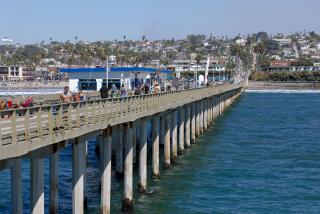Postscript : Oceanside’s Once Washed Up Artificial Reef Plan Is on Course Again
- Share via
OCEANSIDE — When Councilman Sam Williamson proposed the creation of an artificial reef to enhance sportfishing off Oceanside a year ago, the idea was greeted with a chorus of titters and more than a few raised eyebrows.
Why? Because Williamson suggested the reef be built of 150 smashed and gutted cars that an Oceanside auto wrecking company had offered to dump--at no charge--into the sea.
The councilman asserted the auto reef would do wonders for marine life, “protecting the little fish and housing big fish,” much like “the old sunken ships you see in the movies.” But state Department of Fish and Game biologists were skeptical, predicting the steel shells would rust away rapidly. The scientists also protested using the ocean as a receptacle for wrecked cars.
Williamson’s rather unorthodox proposal soon died, a victim of the biologists’ qualms. But now, a year later, it looks as if Oceanside will indeed get an artificial reef--one fashioned, more traditionally, out of 10,000 tons of quarry rock.
Jim Manues, the city’s harbor superintendent, said he is “95% confident” that more than $245,000 in federal money earmarked for the enhancement of coastal fisheries is available for the reef. The DFG has pledged another $81,900, the balance of the project’s cost, he said.
In a related effort, city officials hope to create yet another offshore reef by hauling out to sea and sinking 4,000 feet of hollow, concrete docks that are being removed from Oceanside’s small craft harbor and replaced by new, state-of-the-art floats.
Together, the reefs, which will be marked by buoys so they can be easily located, will “be a tremendous recreational asset to commercial and sportfishermen and divers in the area,” Manues said. “Our offshore waters have always been a hot fishing spot and the new reefs will add to that reputation.”
Biologists say offshore reefs attract fish because they provide a resting place sheltered from ocean currents. They also offer many species of small fish hiding places from larger predators.
But whether reefs actually increase fish populations, or merely entice fish from elsewhere in the ocean, is not known. Under a bill signed recently by Gov. George Deukmejian, DFG biologists will study that question by monitoring experimental reefs. Oceanside’s reef will be the first built and monitored under the program.
“If reefs are found to actually increase the number of fish in the ocean, they could become an important tool for managing our coastal fisheries, which have been hurt by overfishing, loss of wetlands and pollution,” said Carl Nettleton, an executive director of the National Coalition for Marine Conservation, a salt water anglers’ group that lobbied for the bill.
Before city officials can proceed with either reef, Manues said, they must await results of a survey that will recommend locations for the offshore structures.
The movement to construct an artificial reef in Oceanside was prompted by local fishermen, who complained that a rock reef built 1.5-miles offshore in 1964 had become overgrown and difficult to locate. Biologists suspect that reef, once known throughout the county as a prime fishing area, may have become covered by sediment from a nearby sewage plant’s ocean outfall pipe.
More to Read
Sign up for Essential California
The most important California stories and recommendations in your inbox every morning.
You may occasionally receive promotional content from the Los Angeles Times.













